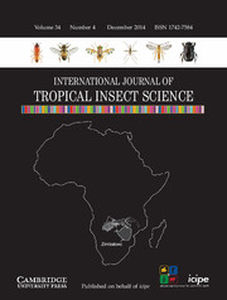Article contents
Stability of resistance to corn planthopper, Peregrinus maidis (Ashmead) in sorghum germplasm
Published online by Cambridge University Press: 19 September 2011
Abstract
Stability of resistance to corn planthopper, Peregrinus maid is (Ashmead), was studied over three plant growth stages in 56 sorghum germplasm accessions. Genotype x stage interactions were significant. Plant age exerted a profound influence on the rate of oviposition, establishment of nymph, macropterous and brachypterous adult populations and plant damage. Resistance to corn planthopper was stable over three growth stages in IS 18557, IS 18677 and PJ 8K(R), which also supported low colonization of nymph and adult populations; IS 12308 was unstable due to high deviation. Significantly low rate of oviposition on resistant as compared to susceptible genotypes and the positive and significant correlation between oviposition and plant damage illustrated that antixenosis for oviposition is the primary mechanism of resistance. As a consequence the genotypes preferred for oviposition showed susceptibility due to higher plant damage. Establishment of nymphs was affected on the genotypes, IS 1054, IS 1082, IS 2194, IS 3992, IS 12308, IS 18676 and IS 19349 which may be due to the factors involved either in reduced hatchability of eggs and/or deterrence or poor feeding preference of nymphs.
Résumé
La stabilité de la résistance à la delphacide du maïs, Peregrinus maidis (Ashmead) a été étudiée sur 3 stades de développement des accessions du germplasme de sorgho. Les interactions génotype x stade sont significatives. L'âge de la plante exerce une grande influence sur le taux de l'oviposition, l'établissement des larves et des populations adultes de macroptères et de brachyptères et sur les dégâts. La résistance de la cicadelle du maïs est stable aux 3 stades de développement chez IS 18557, IS 18677 et PJ 8K(R); celles-ci enregistrent une colonisation faible de populations larvaires et imaginales. IS 12308 est instable en raison de l'écart type élevé. Le taux de l'oviposition sur les génotypes résistants comparés aux sensibles ainsi que la corrélation positive et significative entre l'oviposition et les dégâts sur les plantes, démontrent que l'antixenosis pour l'oviposition est le premier mécanisme de résistance. Comme conséquence, les génotypes préférés pour l'oviposition affichent une grande sensibilité au regard des dégâts sévères observés. L'établissement des larves est affecté sur les génotypes IS 1054, IS 1082, IS 2194, IS 3992, IS 12308, IS 18676 et IS 19349; ceci peut être dû aux facteurs impliqués soit dans la réducation des éclosions des oeufs, soit la deterrence ou la préférence alimentaire faible des larves.
Keywords
- Type
- Research Articles
- Information
- Copyright
- Copyright © ICIPE 1992
References
REFERENCES
- 3
- Cited by


